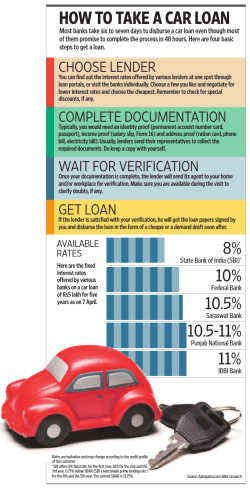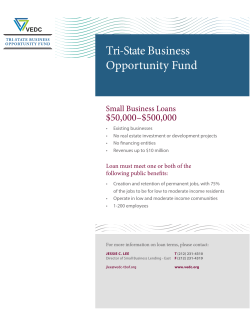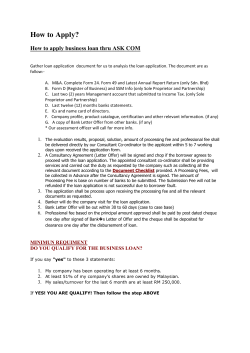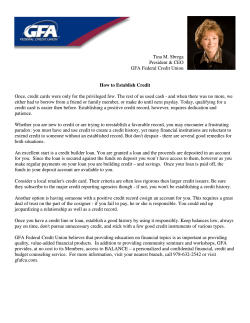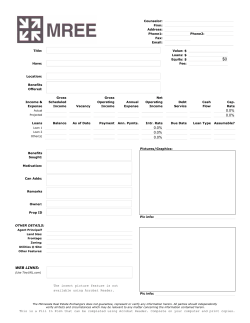
The Affordable Housing Program and Community Investment
The Affordable Housing Program and Community Investment Program of the Federal Home Loan Banks By David Jeffers, Executive Vice President of Policy and Public Affairs, Council of Federal Home Loan Banks T he Federal Home Loan Banks are 12 regional cooperative banks used by lending institutions to finance housing, community development, infrastructure, small business, and jobs in their communities. The Federal Home Loan Banks System was created by Congress in 1932. The Federal Home Loan Banks are regulated by the Federal Housing Finance Agency (FHFA), the successor to the Federal Housing Finance Board. FHFA was created in the Housing and Economic Recovery Act of 2008. FHFA also regulates the Federal National Mortgage Association (Fannie Mae) and the Federal Home Loan Mortgage Corporation (Freddie Mac). The Home Loan Banks are the largest single source of funds for community lending. PROGRAM SUMMARIES Federal Home Loan Banks administer two housing and economic development programs. Affordable Housing Program. Federal Home Loan Banks must contribute 10% of their net income from the previous year to affordable housing through the AHP. The minimum annual combined contribution by the 12 Federal Home Loan Banks must total $100 million. Member banks partner with developers and community organizations seeking to build and renovate housing for low to moderate income households. To ensure that AHP-funded projects reflect local housing needs, each Home Loan Bank is advised by a 15-member Affordable Housing Advisory Council for guidance on regional housing and community development issues. AHP consists of two programs: a competitive application program and a homeowner set-aside program. Under the competitive application program, a Federal Home Loan Bank member submits an application on behalf of a project sponsor. Each Federal Home Loan Bank establishes 5–40 2015 ADVOCATES’ GUIDE a point system to score applications based on nine criteria required by regulation (12 CFR part 1291). AHP competitive awards are made during scheduled funding rounds each year, starting with the highest scoring application until the available money is distributed. If rental housing is developed with AHP funds, at least 20% of the units must be reserved for and affordable to households with income below 50% of the area median income (AMI). Owner-occupied housing must be occupied by a household with income below 80% of AMI. AHP is a shallowsubsidy program; the Federal Housing Finance Agency reports that the average urban area subsidy in 2013 was $8,317 per unit. Under the homeowner set-aside program, a Federal Home Loan Bank member applies for grant funds and disburses the funds directly to the homeowner. A Federal Home Loan Bank may set aside up to $4.5 million, or 35% of its annual HAP contribution, to assist low or moderate income households purchase or rehabilitate homes. At least one-third of a Federal Home Loan Bank’s aggregate annual set-aside contribution must be allocated to first-time homebuyers. The maximum grant amount per household is $15,000. The AHP is designed to help member financial institutions and their community partners develop affordable owner-occupied and rental housing for very low to moderate income families and individuals. Projects serve a wide range of needs. Many are designed for seniors, persons with disabilities, homeless families and individuals, first-time homeowners, and others with limited resources. Project sponsors partner with financial institutions to seek the competitive grants or low-cost loans. Applicants are encouraged to leverage their awards with other funding sources, including conventional loans, government subsidized financing, tax-credit equity, foundation grants, and bond financing. AHP is a flexible program that uses funds in combination with other programs and funding sources, such as print this page Low Income Housing Tax Credits and Community Development Block Grants. Each Federal Home Loan Bank provides training and application assistance. See individual Home Loan Bank websites for details. The Federal Home Loan Banks have distributed more than $4.2 billion in AHP funds between 1990 and 2013. In 2013, the banks used $254 million under the competitive program to assist 27,258 households, and $68 million under the set-aside program to assist 10,000 households. Close to 725,000 housing units were assisted using AHP funds between 1990 and 2013, including 428,000 units for very low income residents. In 2013, 74% of rental units and 53% of owner-occupied units served very low income households, those with income below 50% of AMI; of these, 21% of the rental units and 5% of the owner-occupied units assisted extremely low income households, those with income below 30% of AMI. Community Investment Program. Each Home Loan Bank also operates a CIP that offers belowmarket rate loans to members for long-term financing of housing and economic development that benefits low and moderate income families and neighborhoods. CIP finances housing for households with income below 115% of AMI, including rental projects, owner-occupied housing, and manufactured housing communities. Economic development projects must be located in low and moderate income neighborhoods or benefit low and moderate income households. Under CIP, the banks have lent nearly $74 billion for a variety of projects since the program’s inception two decades ago, creating 797,000 housing units. How the Federal Home Loan Bank System works. The Federal Home Loan Banks, which are government sponsored enterprises, are cooperatives that provide funding for housing through all market cycles. More than 7,500 lenders are members of the Federal Home Loan Bank System, representing approximately 80% of the insured lending institutions in the country. Community banks, thrifts, commercial banks, credit unions, community development financial institutions, insurance companies, and state housing finance agencies are all eligible for membership in the system. The 12 Home Loan Banks are located in Atlanta, Boston, Chicago, Cincinnati, Dallas, Des Moines, Indianapolis, New York, Pittsburgh, San Francisco, Seattle, and Topeka. print this page Each Federal Home Loan Bank has its own board of directors, comprised of members of that Home Loan Bank and independent (non-member) directors. The boards of directors represent many areas of expertise, including banking, accounting, housing, and community development. The primary purpose of the Federal Home Loan Banks is to provide members with liquidity. In fact, the Federal Home Loan Banks are the only source of credit market access for the majority of its members. Most community institutions do not have the ability to access the credit markets on their own. Federal Home Loan Bank loans to members, called “advances,” are a nearly instantaneous way for members to secure liquidity. The Federal Home Loan Banks go to the debt markets several times a day to provide their members with funding. The size of the Federal Home Loan Bank System allows for these advances to be structured in any number of ways, allowing each member to find a funding strategy that is tailored to its needs. In order to qualify for advances, a member must pledge high-quality collateral, in the form of mortgages, government securities, or loans on small business, agriculture, or community development. The member must also purchase additional stock in proportion to its borrowing. Once the member’s Home Loan Bank approves the loan request, it advances those funds to the member institution, which then lends the funds out in the community for housing and economic development. Each of the 12 regional Federal Home Loan Banks is self-capitalizing. During times of high advance activity, capital automatically increases. As advances roll off the books of the Federal Home Loan Banks, capital is reduced accordingly. During the financial crisis, the Federal Home Loan Banks continued to provide liquidity nationwide to members for housing and community credit needs through an extremely challenging period of economic stress. As other sources of liquidity disappeared, and before the coordinated response of the federal government, the system increased its lending to members in every part of the country by 58% between the second quarter of 2007 and the third quarter of 2008. Advances exceeded $1 trillion in the third quarter of 2008. Member demand for advance borrowings continued to be lower as members’ loans outstanding NATIONAL LOW INCOME HOUSING COALITION 5–41 decreased while their deposit base continued to grow, both as a result of the economic contraction. As of the end of the third quarter of 2010, system advances outstanding totaled $500 billion. This was a decline from $631 billion in advances outstanding to start the year, and a decline from the high of $1 trillion in advances for the third quarter of 2008. However, one of the benefits of the system’s regional, self-capitalizing, cooperative business model is the ability to safely expand and contract to meet member lending needs throughout various business cycles. Federal Home Loan Banks are jointly and severally liable for their combined obligations. That means that if any individual Federal Home Loan Banks would not be able to pay a creditor, the other 11 Federal Home Loan Banks would be required to step in and cover that debt. This provides another level of safety and leads to prudent borrowing throughout the system. FUNDING No taxpayer funds are involved in the operation of the privately owned Federal Home Loan Banks. The Federal Home Loan Banks’ Office of Finance, the clearinghouse for Home Loan Bank debt transactions, accesses the global capital markets daily. Federal Home Loan Bank debt is sold through a broad, international network of about 100 underwriters. FORECAST FOR 2015 In the wake of the nation’s financial crisis, concerns over systemic risk remain on everyone’s mind. In eight decades, the Federal Home Loan Banks have never incurred a credit loss on an advance. This record can be attributed to the collateralization of all advances, conservative underwriting standards, and strong credit monitoring policies. In response to the crisis in the U.S. financial market, policymakers will consider proposals to restructure the regulatory system for U.S. financial institutions. Advocates should look at how any proposed restructuring would affect the Home Loan Banks. 5–42 2015 ADVOCATES’ GUIDE In any discussion about the future of housing finance, advocates should remember that: • The regional, self-capitalizing Federal Home Loan Bank cooperative model is designed to protect against pursuing risky behavior. • Federal Home Loan Bank advances to members are fully secured and follow strict underwriting standards. • The Federal Home Loan Bank mortgage programs require participating lenders to share in the credit risks of their mortgage loans, thereby keeping “skin in the game.” • The Federal Home Loan Banks have fulfilled their role in the housing finance system without any Congressional appropriations or direct federal assistance. WHAT TO SAY TO LEGISLATORS The Federal Home Loan Banks have a number of programs and products that can help drive economic recovery. Their community lending programs can be utilized to help drive job growth at the local level. The system’s AHP grants have remained a reliable and stable source of muchneeded affordable housing funding, even as other sources of affordable housing funding have dried up. The role the Federal Home Loans Banks play in the financial system is vitally important. In any restructured housing finance system, the Federal Home Loan Banks must continue to function as steady and reliable sources of funds for housing and community development through local institutions. n FOR MORE INFORMATION Council of Federal Home Loan Banks, www.cfhlb.org Federal Housing Finance Agency, Affordable Housing Home Loan Banks, http://1.usa.gov/1MasKxX print this page
© Copyright 2025


